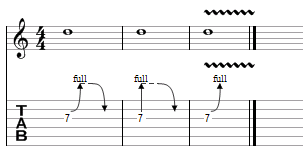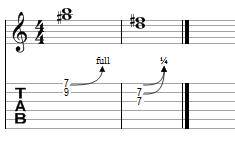Bending strings is extremely common in most forms of guitar playing. Every guitar player on the planet has at some point bent strings. It sounds great and above all it’s fun too.
To bend a string, all we need to do is play a note as normal, and then literally bend the string by pushing it along the same fret towards you, or away from you toward the floor. Generally we just bend in the direction we have more room, or which is more comfortable. The direction we bend doesn’t make a difference. For example if we’re bending notes on the ‘b’ string, we would bend the string up wards along the fret toward the low E string.
Here is how bending is shown on tab notation.

The scooped looking arrow tells us to bend the string. And the number attached to the arrow tells us how many tones to bend the note too.
When we bend strings we are also shifting the pitch of the note. In other words when we bend a string we make that note go higher. The more we bend it, the higher it goes.
The first bend in this example tells us the bend the note ½ a tone. Which is the same as a semi-tone. So in this example we need to bend that 12th fret ‘g’ note ½ a tone up to a g#.
So what we need to do is, strike that 12th fret g note as normal, and then bend the note until it plays at the same pitch as if you had played the 13th fret note. The next bend in that example asks for a full bend, which is the same as one tone. The next too bends are bigger bends that are less common and require the string to be bent quite a distance.
Bending notes more than ½ tone requires a bit of muscle and its recommended to use more than one finger when pushing the strings. It’s common to use three fingers, while some guitarists even like to use all four.
Another thing to take note of is the angle of the slope of the bent arrow. The curve of the line gives us a general indication of how fast we should bend the string. The steeper the curve the faster we should be bending.
This example demonstrates how bending can be used in place of regular fretted notes.

The first bar plays an ‘d’ note and ‘e’ note twice. The next bar plays the same two notes. But this time instead of playing the ‘e’ note using the 9th fret of the g string, we play that ‘e’ note by bending the 7th fret up one tone. We bend the ‘d’ note up to a ‘e’.
We do a similar thing in the next two bars only with different notes and using a smaller bend. The 3rd bar plays an ‘f#’ note and a ‘g’ note twice. The bar does the same thing only we bend the ‘f#’ note ½ a tone to the ‘g’ note instead of playing that 8th fret.
Listen to the example.
Here are some other types of bend.

The first is a bend and release. The bend arrow is followed by another arrow curving downwards. This tells us, that after we bend up to where ever we need to go, we need to bend the note back to its original position.
The next bend is a pre-bend. The arrow pointing up means that we need to bend the note to where we need, before we strike the string. And then bend back to its original position. Pre-bends sound like bends going in reverse.
The last is just a bend with vibrato added once we’ve bent the string.
Have a listen.
Finally there are two other types of bend common to rock and blues music in particular.

The first is called a unison bend. We play a bent note together with a normally fretted note. This can give a strong harmonising sound and can make the bend sound more aggressive. In this example we play the 7th fret note on the top ‘e’ string as normal, but bend the 9th fret note on the ‘b’ string one tone.
To do this we play the 7th fret note with our 1st finger, and use our remaining three fingers to bend that other note. We strike both strings at the same time.
In the next example we’re asked to bend two notes at the same time. We do this by using the flat part of one of our fingers too play and bend both notes. Since bending two strings with one finger is quite tough, these types of bend are often very small. In this example it asks for a ¼ bend. Which is even less than a semitone. So we would bend the string making the notes go up, less than a semitone. Since the notes on our guitars go up in semitone it’s not really possible to measure and hear ¼ of a tone so complete accuracy isn’t really needed for such small bends. And generally when asked to bend a ¼ tone we’re really being told to ‘just bend it a bit’.
One final important thing when bending is to bend in key. This means when bending notes, be careful not to bend up too notes that are out of key.
Let’s say we are playing a melody in C major and we want to bend a ‘c’ note. Bending that note one full tone up to a ‘d’ note is fine since ‘d’ is a note from c major scale. However if we were to bend it too far and end up at a ‘d#’ then that bent note will be out of key. Since there is no ‘d#’ in C major. And if you are playing over a chord progression which is also sticking to c major, that bent note may sound wrong.
That’s not to say we always have to bend strictly in key but its something to keep in mind.
Enjoy bending strings!
